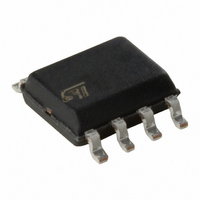M41T11M6E STMicroelectronics, M41T11M6E Datasheet - Page 16

M41T11M6E
Manufacturer Part Number
M41T11M6E
Description
IC SRL RTC 512BIT 8SOIC
Manufacturer
STMicroelectronics
Type
Clock/Calendar/NVSRAMr
Datasheet
1.M41T11M6F.pdf
(30 pages)
Specifications of M41T11M6E
Memory Size
56B
Time Format
HH:MM:SS (24 hr)
Date Format
YY-MM-DD-dd
Interface
I²C, 2-Wire Serial
Voltage - Supply
2 V ~ 5.5 V
Operating Temperature
-40°C ~ 85°C
Mounting Type
Surface Mount
Package / Case
8-SOIC (3.9mm Width)
Function
Clock/Calendar/Timekeeper
Rtc Memory Size
64 Byte
Supply Voltage (max)
5.5 V
Supply Voltage (min)
2 V
Maximum Operating Temperature
+ 85 C
Minimum Operating Temperature
- 40 C
Mounting Style
SMD/SMT
Rtc Bus Interface
Serial (2-Wire, I2C)
Lead Free Status / RoHS Status
Lead free / RoHS Compliant
Other names
497-2813-5
M41T11M6
M41T11M6
Available stocks
Company
Part Number
Manufacturer
Quantity
Price
Company:
Part Number:
M41T11M6E
Manufacturer:
STMicroelectronics
Quantity:
1 895
Part Number:
M41T11M6E
Manufacturer:
ST
Quantity:
20 000
Clock operation
3.2
3.3
16/30
adjustment per calibration step in the calibration register. Assuming that the oscillator is in
fact running at exactly 32,768 Hz, each of the 31 increments in the calibration byte would
represent +10.7 or –5.35 seconds per month which corresponds to a total range of +5.5 or
–2.75 minutes per month.
Two methods are available for ascertaining how much calibration a given M41T11 may
require. The first involves simply setting the clock, letting it run for a month and comparing it
to a known accurate reference (like WWV broadcasts). While that may seem crude, it allows
the designer to give the end user the ability to calibrate his clock as his environment may
require, even after the final product is packaged in a non-user serviceable enclosure. All the
designer has to do is provide a simple utility that accessed the calibration byte.
The second approach is better suited to a manufacturing environment, and involves the use
of some test equipment. When the frequency test (FT) bit, the seventh-most significant bit in
the control register, is set to a '1', and the oscillator is running at 32,768 Hz, the FT/OUT pin
of the device will toggle at 512 Hz. Any deviation from 512 Hz indicates the degree and
direction of oscillator frequency shift at the test temperature.
For example, a reading of 512.01024 Hz would indicate a +20 ppm oscillator frequency
error, requiring a –10(XX001010) to be loaded into the calibration byte for correction. Note
that setting or changing the calibration byte does not affect the frequency test output
frequency.
Output driver pin
When the FT bit is not set, the FT/OUT pin becomes an output driver that reflects the
contents of D7 of the control register. In other words, when D6 of location 7 is a zero and D7
of location 7 is a zero and then the FT/OUT pin will be driven low.
Note: The FT/OUT pin is open drain which requires an external pull-up resistor.
Preferred initial power-on defaults
Upon initial application of power to the device, the FT bit will be set to a '0' and the OUT bit
will be set to a '1'. All other register bits will initially power on in a random state.
M41T11













